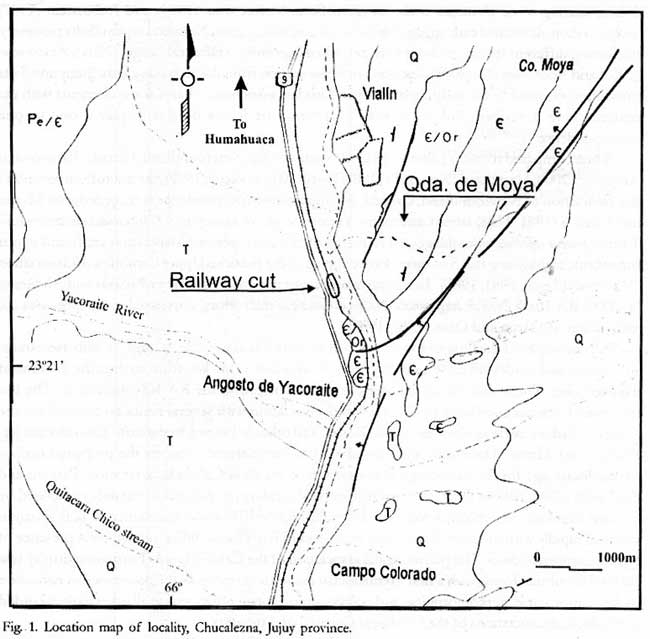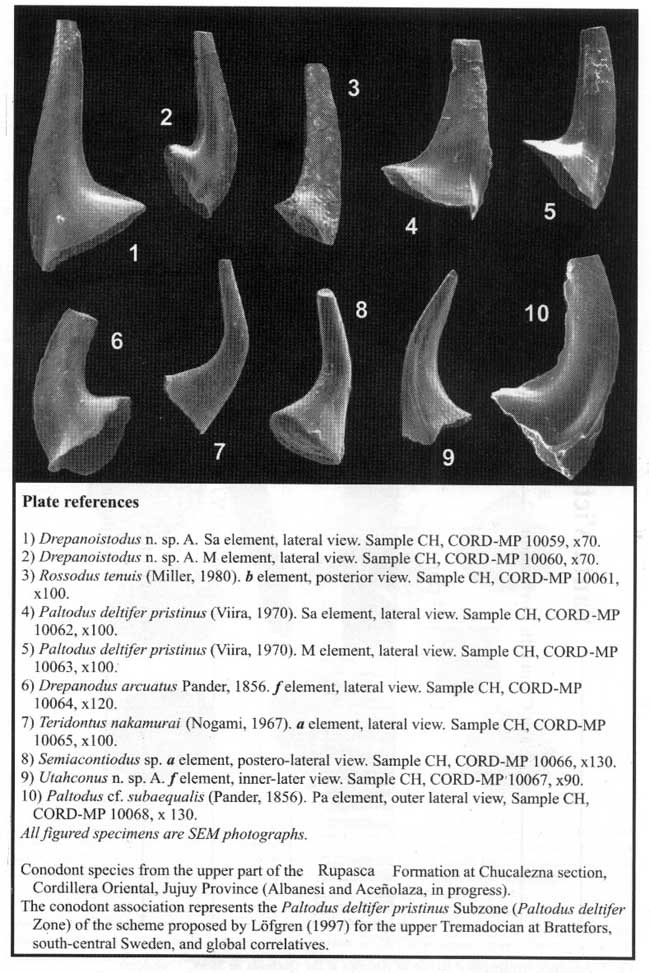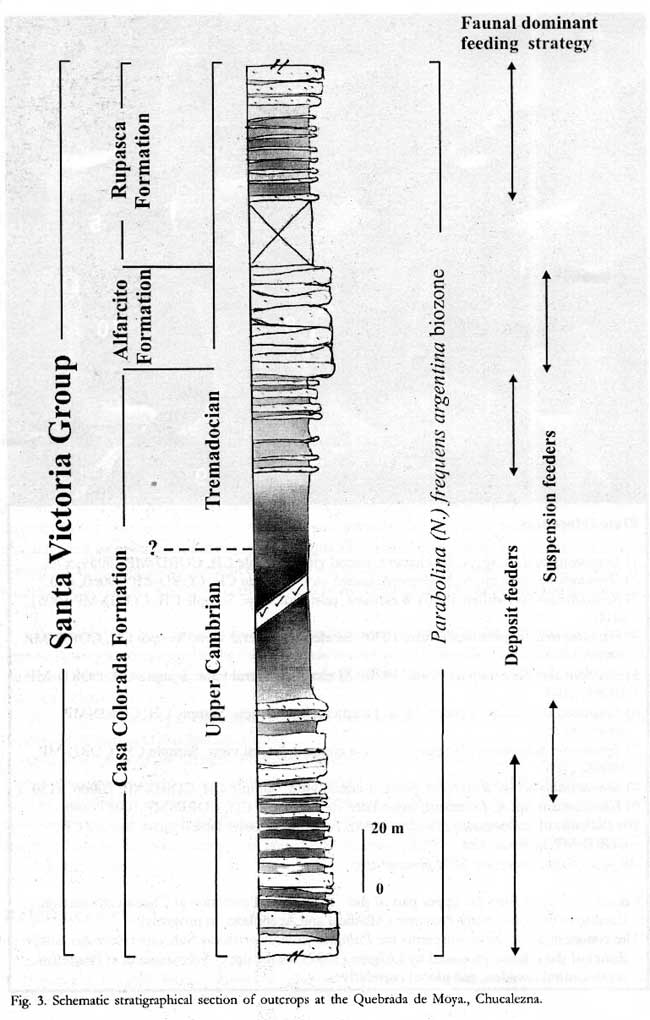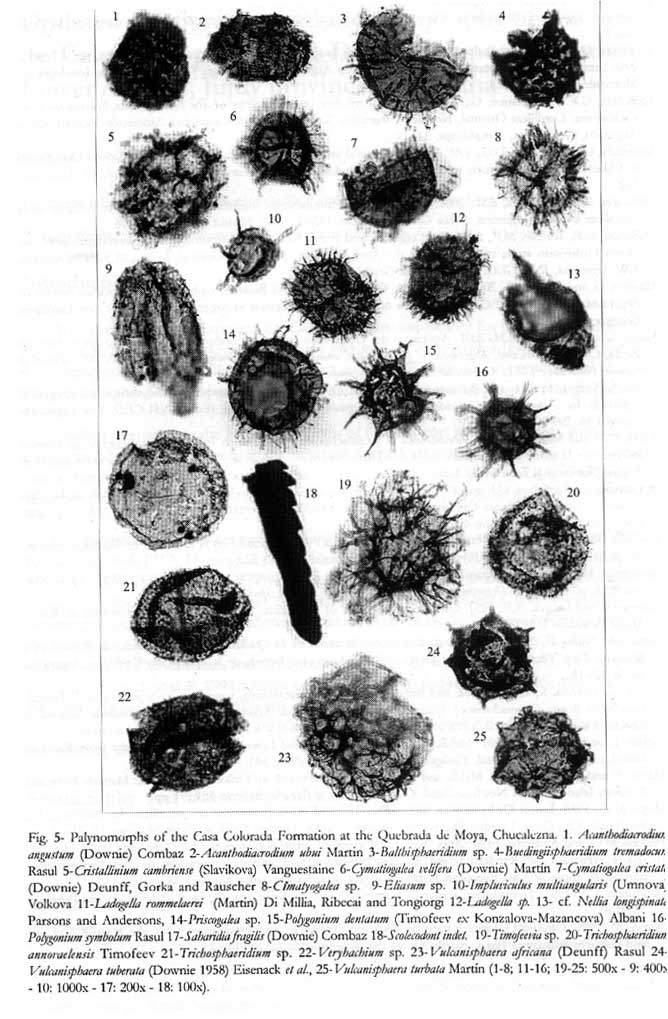
Biostratigraphical and sedimentological aspects of the Cambro-Ordovician strata at the Angosto de Chucalezna: new palynological data (Jujuy, NW Argentina)
Guillermo F. ACEÑOLAZA1, Lucía ARÁOZ1, Daniel G. POIRÉ2,
María del Milagro VERGEL3 and Guillermo ALBANESI4
1 INSUGEO – Facultad de Ciencias Naturales e I.M.L., Universidad Nacional de Tucumán, Miguel Lillo 205, 4000 Tucumán. E-mail: insugeo@unt.edu.ar
2 Centro de Investigaciones Geológicas (CONICET-UNLP). Calle nº 1, 644. 1900 La Plata, Argentina. E-mail: poire@cig.museo.unlp.edu.ar
3 CONICET – Facultad de Ciencias Naturales e I.M.L., Universidad Nacional de Tucumán. Miguel Lillo 205, 4000 Tucumán. E-mail: mvergel@csnat.unt.edu.ar
4 CONICET – facultad de Ciencias Exactas, Físicas y Naturales, Universidad Nacional de Córdoba. Av. Vélez Sarsfield y Duarte Quirós, 5000 Córdoba. E-mail: galbanesi@arnet.com.ar
Palabras clave: Estratigrafía. Bioestratigrafía. Cambro-Ordovícico. Palinomorfos. Chucalezna. Jujuy. NW Argentina.
Key words: Stratigraphy. Biostratigraphy. Cambrian-Ordovician. Palynomorphs. Chucalezna. Jujuy. NW Argentina.
Introduction
Cambro-Ordovician strata of the Cordillera Oriental of Jujuy province display widely distributed fossiliferous outcrops, studied by many authors over one hundred years. The Angosto de Chucalezna is one of those localities, with two easy to reach sections with abundant and well preserved fossils, particularly trilobites, palynomorphs and ichnofossils: 1 - The railway section in the western flank of the Rio Grande, and 2- The Quebrada de Moya section eastwards, on the slope of the homonymous peak (Fig. 1).
Paleontological studies have provided several diagnostic elements to date these strata as Upper Cambrian – early Upper Tremadocian (Moya, 1988; Aceñolaza, 1996; Aceñolaza and Albanesi, 1996; Aceñolaza and Poiré, 1998; 1999; Di Cunzolo et al., 2003).
A thick and faulted succession of sandstones and shales of the Mesón and Santa Victoria groups will be examined at this locality. The Cambrian Mesón Group will not be analyzed in detail, but the sedimentologic and paleontologic elements of the Casa Colorada, Alfarcito and Rupasca formations (Santa Victoria Group) will be focused in this opportunity. Tidal and wave dominated successions within a shoreface setting characterize all sequences of this locality, that has been proposed as an ichnological interest point due to the nicely preserved trace fossils associations and the vicinity to a main route (Aceñolaza, 2001a).
In this contribution will be revisited the main aspects of the stratigraphy and biostratigraphy of this locality will be revisited, presenting for the first time a rich and varied palynological association within the upper levels of the Casa Colorada Formation, here referred to the lowermost Tremadocian,
close to the Cambro-Ordovician boundary.
Stratigraphy and Biostratigraphy
The Casa Colorada Formation (Harrington, 1957; emmend. López and Nullo, 1969) display a thick succession of green and black shales and subordinated sandstones. The unit display a lower sandier and an upper shalier interval. The lower sandier sector of the formation has frequently been considered as a different unit (eg. "Alfarcito Formation"), but in this oportunity the entire sequence is understood as one lithological element, as originally defined by Harrington (1957). Following sedimentary characters and paleontological evidence, the Casa Colorada Formation is interpreted as shoreface sedimented strata, within an upper offshore / middle shoreface setting. Deposit feeders are the dominant group reflected by trace fossils, with a proportional less participation of suspension feeders (Di Cunzolo et al., 2003). Sandstone intercalations within the shalier sector of the Casa Colorada Formation and equivalent units were interpreted as storm layers inhabited by oportunistic faunas (Aceñolaza, 1996; Aceñolaza, 2001a, 2001b; Di Cunzolo et al., 2003). Trilobites of the Parabolina (N.) frequens argentina biozone were also recognized in the locality (Aceñolaza, 1996), while monotaxic (brachiopods) and bitaxic (brachiopod-trilobite) bioclasts accumulations have also been described (Aceñolaza and Nieva, 2001).
The Casa Colorada Formation is transitionally followed by the scarcely fossiliferous sandstones and quartzites of the Alfarcito Formation (Harrington, 1957; emmend. López and Nullo, 1969). The transitional levels between both units are characterized by an heterolithic sequence of shales and sandstones that have provided a new association of palynomorphs (see data below).
Large to medium scale cross bedded and sigmoidal sandstone bodies with clear reactivation surfaces, infrequent mud drapes, amalgamated and interbedded cross stratified sandstones with frequent herringbone cross-stratification characterize the Alfarcito Formation. Sedimentary strata and ichnological evidence supports a lower shoreface to upper shoreface sedimentary setting. Trace fossils are not abundant, with a clear dominance of suspension feeders ("Skolithos ichnofacies"). Fossils are scarce due to the taphonomic and environmental history of strata. The Cambro-Ordovician Parabolina (N.) frequens argentina trilobite biozone is also recorded all across strata. Bitaxic bioclast accumulations were also mentioned and its taphonomy analysed (Aceñolaza and Nieva, 2001).
Above the Alfarcito Formation follows the greenish - grayish shales and sandstones of the Rupasca Formation (Harrington, 1957; emmend. López and Nullo, 1969). Trilobites of the Bienvillia tetragonalis-Shumardia (Conophrys) minutula and Notopeltis orthometopa biozones were described from this unit, with Shumardia (Conophrys) minutula, Hapalopleura clavata, Asaphellus jujuanus, Leptoplastides mariana and Protopeltura mesembria among the most distinctive elements (Aceñolaza, 1996). Conodonts of the Paltodus deltifer biozone (early Upper Tremadocian) were recovered from carbonate cemented coquinite levels of the upper part of the sequence in the railway cut: Drepanodus arcuatus, Drepanoistodus aff. concavus, Paltodus deltifer, Rossodus tenuis and Teridontus nakamurai (Aceñolaza and Albanesi, 1996; Albanesi and Ortega, 2002). An upper offshore to transitional setting within a shoreface model was interpreted for the unit (Di Cunzolo et al., 2003). Strata is disrupted upwards by faulting.
Palynomorphs of the Casa Colorada formation
A new diversified microfloristic assemblage with relatively good preservation has been recovered from the upper sector of the Casa Colorada Formation (Fig. 5). This is characterized by the dominant presence of taxa belonging to diacromorphitae (Acanthodiacrodium, Ladogella) acanthomorphitae (Vulcanisphaera) and herkomorphitae (Cristallinium, Cymatiogalea) forms.

The following taxa were identified: Acanthodiacrodium achrassi, A. angustum, A. crassus, A. ubui, A. spp., Baltisphaeridium sp., Buedingiisphaeridium tremadocum, Cristallinium cambriense, Cymatiogalea velifera, C. cristata, C. spp., Eliasum sp., Impluviculus multiangularis, Ladogella rommelaerei, Leiosphaeridia sp., Lophosphaeridium sp., Mychrystridium sp., cf. Nellia longispinata, Nellia? sp., Priscogalea sp., Polygonium dentatum, P. symbolum, P. sp, Saharidia downie, S. fragilis, Timofeevia sp., Trichosphaeridium annovaelensis, T. sp., Veryhachium sp., Vulcanisphaera africana, V. tuberata, V. turbata, and an indetermined Scolecodont.
Most of these taxa were earlier mentioned for either late Cambrian and early Ordovician strata, with many elements crossing the Cambro-Ordovician boundary. It is interesting to point out the lack of typical and exclusive Cambrian taxa, with the exception of Eliasum and Vulcanisphaera turbata, whose presence may obey to resedimentation. In addition, Fombella Blanco (1982) records Eliasum up into the Tremadocian.
The presence of the Ordovician Acanthodiacrodium angustum provides interesting elements to the chronological discussion, because this form is usually recorded associated to the guide fossil Rhabdinopora flabelliformis.
The early mentioned elements supports a lowermost Ordovician age, close to the Cambro-Ordovician boundary, for the upper levels of the Casa Colorada Formation.
Palynomorphs of the Casa Colorada Formation were also compared to other Cambro-Ordovician associations. No typical and exclusively Cambrian palynomorph associations have been recorded for Argentina yet. In Salta Province Bultynck and Martin (1982) mentioned the presence of Tremadocian forms, sharing some elements with our microflora. Manca et al. (1995) and Rubinstein (1997) analyze a more diversified early to late Tremadocian assemblage from Nazareno region (Salta province), presenting different species to those here described. Recently, Aráoz and Vergel (2001), Aráoz et al. (2002) and Aceñolaza et al.(2003) describe a new association from the Sierra de Zenta (Jujuy and Salta provinces) assigned to the early Tremadocian. This last association shares some elements with the material here described, but the overall proportion of forms do not display a one to one correspondence.
When compared to other palynological associations (e.g. Newfoundland, Canadá: Parsons and Anderson, 2000; Martin and Dean, 1981, 1988; North Africa: Vecoli, 1999), the microflora resembles the association of Newfoundland, Canadá. An important correspondence is recorded with Martin and Dean ´s (1981, 1988) latest Cambrian – Tremadocian A6 association (Arbusculidium destombesii-Vulcanisphaera capillata assemblage). 10 elements of the early referred association are found in our microflora, highlighting that 5 of them do not appear in the previous Upper Cambrian A5 association (Martin and Dean, 1981; 1988). In a same manner, our material is similar to Parsons and Anderson ‘s (2000) RA 10a-b Nellia? longispinata-Nellia sukatschevii microflora, correlated to the previous A6 association of Martin and Dean (1981; 1988).
Palynomorphs of the Casa Colorada Formation share 9 taxa with the "a" and "b" sub-asociations of Parsons and Anderson (2000), highligthing A. angustum as the key form to date the lowermost Tremadocian. These data allows a closer correspondence with the RA 10b microflora. The last mentioned authors compared their RA10b sub-association with several zones recognized for the Cambro-Ordovician boundary (eg. China, Russia) and other belonging to the early Tremadocian (eg. Europe and Africa). These data when compared to our material supports the proposed earliest Tremadocian age for the palynological association of the Casa Colorada Formation. Parsons and Anderson (2000) believe that Cambro-Ordovician boundary microfloras are mainly composed by survival Cambrian assemblages with very few subordinated Tremadocian elements. This situation changed rapidly with the diversification of new taxa in Tremadocian times, reducing the presence of typical Cambrian forms. The palynological association of the Casa Colorada Formation display few survival Cambrian forms with a first Tremadocian association that lacks the posterior diversification of diacromorphitae, herkomorphitae and polygonomorphitae, as happens in all other early recorded palynological associations of the Cordillera Oriental of Argentina.
After comparing the recently established palinozones of Vecoli (1999) for northern Africa, our microflora does not have a full correspondence with those of the Upper Cambrian (Timofeevia phosphoritica-Dasydiacrodium caudatum assemblage zone) or the earliest Tremadocian (Acanthodiacrodium simplex-Arbusculidium destombesii assemblage zone). With the first assemblage shares Ladogella rommelaerei, a typical component of Cambrian associations, but also recorded in Tremadocian associations and several less important biostratigraphic forms as C. velifera, S. fragilis, V. africana and A. achrassi. The abundant herkomorphitae and diversified acanthomorphitae in the second association of Vecoli did not allow a closer correspondence.
Taking in account the mentioned basis, we interpret that this new association from the Quebrada de Moya could be considered slightly older than any earlier mentioned association from Argentina, within the lowermost Tremadocian.
Stop 1- Railway cut by the western flank of the Rio Grande
(early Upper Tremadocian Rupasca Formation)

Thirty nine meters of pale yellowish and greenish shales and sandstones, with thickenning upwards both strata and grain arrangement, are displayed in the railway cut by the route 9 at the Angosto de Chucalezna. The upper sector of the strata displays few coquina type storm layers that provided conodonts of the early Upper Tremadocian Paltodus deltifer biozone (Aceñolaza and Albanesi, 1996; Albanesi and Ortega, 2002) (Fig. 2).
The sequence is highly fossiliferous (dominated by trace fossils), and has been several times analysed (Aceñolaza, 1996; Aceñolaza and Albanesi, 1996; Aceñolaza and Poiré, 1999; Di Cunzolo et al., 2003). The infrequent Hapalopleuriid trilobites of Harrington and Leanza (1957) can here be seen (if found).
An heterolithic sequence of mudstones and wave rippled sandstones characterize the lower and middle interval of the section, while the upper sector is distinguished by amalgamated hummocky cross bedded sandstones.
The section display a strong relation between sedimentary facies and trace fossils. The heterolithic facies show a clear dominance of Teichichnus rectus and Trichophycus isp., while Cruziana and Rusophycus (Cruziana furcifera, Cruziana semiplicata, Rusophycus polonica, Rusophycus latus, Rusophycus isp.) appear in soles of the cross bedded sandstones. Arenicolites, Didymaulichnus, Dimorphichnus, Phycodes palmatus, Skolithos and Monocraterion are more frequently found in the sandier interval. The last mentioned ichnoassiciation crosscut Cruziana and Rusophycus (Aceñolaza and Poiré, 1996).
The section is disrupted in the upper and lower sectors by faulting.
Stop 2- Quebrada de Moya section
(Cambro-Ordovician Casa Colorada and Alfarcito formations)
10 km south of Huacalera locality by the eastern flank of the Rio Grande the Quebrada de Moya section display a fairly good faulted sedimentary succession (Fig. 3). The 150 meters thick sequence is represented by the Casa Colorada, Alfarcito and partially the Rupasca formations. Strata are characterized by several intrusives crosscutting its siliciclastic stratigraphy. The Cambrian Mesón Group underlies the entire sequence, while the Rupasca Formation shales and sandstones are tectonically in contact with the overlying Quaternary strata of the Uquía Formation (Aceñolaza, 1996).
Olenid trilobites are dominant fossils in the sedimentary succession. The Parabolina (N.) frequens argentina biozone is represented in the Casa Colorada and the scarcely fossiliferous Alfarcito formations, while the Bienvillia tetragonalis-Shumardia (Conophrys) minutula biozone is displayed in the upper Rupasca Formation.
The newly presented palynomorph association was recovered from the upper levels of the Casa Colorada Formation at this section (Fig. 5).
Coquinite levels of the Alfarcito Formation yielded few elements assigned to Drepanodus arcuatus (conodonta), but no diagnostic conodonts were found in association (Aceñolaza, 1996).
The fragmentary outcrop of the Rupasca Formation in the Quebrada de Moya belongs to lowermost sector of the unit, while the outcrops of the railway cut by the western flank of the river are placed above the first. Asaphacean and Hapalopleuriid trilobites as well as small lingulids are found in these strata.



References
Aceñolaza, G.F., 2001a. El Angosto de Chucalezna: una localidad clásica para el estudio de icnofósiles en el noroeste argentino. IV Reunión Argentina de Icnología y 2da Reunión de Icnología del Mercosur. Resúmenes, 19.
Aceñolaza, G.F. 2001b. Icnofòsiles Cambro-Ordovícicos asociados a facies de lutitas negras: el caso de la Formación Lampazar en el noroeste argentino. IV Reunión Argentina de Icnología y 2da Reunión de Icnología del Mercosur. Resúmenes, 18.
Aceñolaza, G.F. and Albanesi, G., 1996. Conodont trilobite biostratigraphy of the Santa Rosita Formation from Chucalezna, Cordillera Oriental, Northern Argentina. Reunión de Comunicaciones Asociación Paleontológica Argentina, Resúmenes, Ameghiniana, 34: 114.
Aceñolaza, G.F. and Poiré, D.G., 1999. Trace fossils and sedimentology of Rupasca Formation (Lower Ordovician) in Chucalezna, Jujuy Province, northern Argentina. Acta Universitatis Carolinae – Geologica, Vol. 43 (1/2): 159-162.
Aceñolaza, G.F. and Nieva, S.M., 2001. Sobre algunas acumulaciones fosilíferas en el Ordovícico Inferior de la Cordillera Oriental Argentina. Boletin Geológico y Minero 112(4): 35-42. Madrid. ISSN 0366-0176
Aceñolaza, G.F., Tortello, M.F., Aráoz, L., Vergel, M. and Nieva, S.M. 2003. Paleontology and biostratigraphy of the Lower Ordovician strata cropping out at the Abra de Zenta (Cordillera Oriental, Jujuy and Salta provinces), NW Argentina, INSUGEO, Serie Correlación Geológica 17.
Albanesi, G. and Ortega, G., 2002. Advances on Conodont-Graptolite Biostratigraphy of the Ordovician System of Argentina. In: Aceñolaza F.G. (Ed.). Aspects of the Ordovician System in Argentina. INSUGEO, Serie Correlación Geológica, 16: 143-166.
Aráoz, L. and Vergel, M.d.M. 2001. Acritarcos del Ordovícico Inferior (Formación Santa Rosita) en el Abra de Zenta, Cordillera Oriental, Argentina. V Jornadas de Comunicaciones. Serie Monográfica y Didáctica. Nº 41. Facultad de Ciencias Naturales e I.M.L, Universidad Nacional de Tucumán. p. 55.
Aráoz, L, Vergel, M.d.M. and Rubinstein, C.V. 2002. Ordovician palynomorphs of Argentina: an integrated approach. In: Aspects of the Ordovician System in Argentina. Aceñolaza, F.G. (Ed.). INSUGEO, Serie Correlación Geológica 16: 209-224.
Bultynck, P. and Martin, F. 1982. Conodontes et Acritarches de l’ Ordovicien Inférieur et acritarches du Silurien inférieur de la partie septentrionale de la Cordillère Argentine. Bulletin de l’ Institut royal des Sciences naturelles de Belgique, Sciences de la Terre. 53 (4): 1-21.
Di Cunzolo, S., Aceñolaza, G.F. and Rodríguez Brizuela, R., 2003. ¨Cruziana-Skolithos¨ ichnoassociation in the Casa Colorada Formation (Upper Cambrian-Tremadocian), Cordillera Oriental of Jujuy province, NW Argentina. INSUGEO, Serie Correlación Geológica 17.
Fombella Blanco, M.A. 1982. Determinación palinológica del Tremadociano en la localidad de Verdiago, provincia de León, NO de España. Revista Española de Paleontología. XIV: 13-22.
Harrington, H.J., 1957. Ordovician Formations of Argentina. In: Harrington and Leanza, A.F., (1957). Ordovician Trilobites of Argentina. Department of Geology, University of Kansas, Special Publication 1: 1-39.
Harrington and Leanza, A.F., 1957. Ordovician Trilobites of Argentina. Department of Geology, University of Kansas, Special Publication 1: 1-276.
López and Nullo, F., 1969. Geología de la margen izquierda de la Quebrada de Humahuaca, de Huacalera a Maimará. Dep. Tilcara, Provincia de Jujuy, república Argentina. Revista de la Asociación Geológica Argentina, 24 (3): 173-182.
Manca, N., Heredia, S., Hunicken, M. and Rubinstein, C. 1995. Macrofauna, conodontes y acritarcos de la Formación Santa Rosita (Tremadociano), Nazareno, provincia de Salta, Argentina. Boletín de la Academia Nacional de Ciencias de Córdoba. 60 (3-4): 267-275.
Martin, F. and Dean, W.T. 1981. Middle and Upper Cambrian and Lower Ordovician acritarchs from Random Island, eastern Newfoundland. Geological Survey of Canada. Bulletin 343: 43 pp.
Martin, F. and Dean, W.T. 1988. Middle and Upper Cambrian acritarch and trilobite zonation at Manuels River and Random Island, eastern Newfoundland. Geological Survey of Canada. Bulletin 381: 91 pp.
Moya, M.C., 1988. Lower Ordovician in the southern part of the argentineEastern cordillera. In: Bahlburg, H., Breitkreuz, Ch., Giese, P (eds.) The Southern Central Andes, Lecture Notes in Earth Sciences, 17, 55-69.
Parsons, M.G. and Anderson, M.M. 2000. Acritarch microfloral succession from the Late Cambrian and Ordovician (Early Tremadoc) of Random Island, Eastern Newfoundland, and its comparison to coeval microfloras, particularly those of East European Platform. AASP Contributions Series. Number 38.
Rubinstein, C.V. 1997. Tremadocian acritarchs from northwestern Argentina. Review of Palaeobotany and Palynology. 98: 41-45.
Vecoli, M. 1999. Cambro-Ordovician palynostratigraphy (acritarchs and Prasinophytes) of the Hassi-R´Mel area and northern Rhadames Basin, North Africa. Palaeontographia Italica. 86: 1-112.